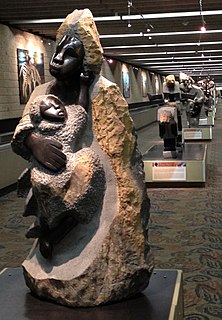Related Research Articles

Zimbabwe has many different cultures, which may include beliefs and ceremonies, one of them being Shona. Zimbabwe's largest ethnic group is Shona.

The Shona people are a Bantu ethnic group native to Southern Africa, primarily Zimbabwe. They have five major clans.
Nicholas Mukomberanwa was a Zimbabwean sculptor and art teacher. He was among the most famous products of the Workshop School at the National Gallery of Zimbabwe and an art mentor and teacher to the Mukomberanwa Family of sculptors. His work has been exhibited in galleries around the world and he remains one of Zimbabwe's most famous artists.
Lawrence Mukomberanwa is a Zimbabwean sculptor.
Netsai Mukomberanwa is an acclaimed Zimbabwean sculptor. She is a second generation Shona art sculptor that works with stone as a medium. She spends afternoons producing her work at the family farm in Ruwa; her primary job is as a school teacher.
Ennica Mukomberanwa is a Zimbabwean sculptor. The daughter of Grace Mukomberanwa and Nicholas Mukomberanwa, she was trained by the first generation of sculptures. Her work is exhibited in private collections and at galleries around the world. She is a third generation Zimbabwean sculptor. In 2004, she was awarded a prize which allowed her to travel to Stockholm, Copenhagen, Scotland, and Canada. She is a member of the Mukomberanwa family of sculptors. She is the daughter of Grace Mukomberanwa and Nicholas Mukomberanwa, who served as her mentor. She is the sister of sculptors Anderson, Netsai, Taguma, Tendai Mukomberanwa and Lawrence Mukomberanwa, and the cousin of Nesbert Mukomberanwa.
Taguma Mukomberanwa is a Zimbabwean sculptor. The son of Nicholas Mukomberanwa, he is the brother of sculptors Anderson, Lawrence, Ennica, and Netsai Mukomberanwa, and the cousin of Nesbert Mukomberanwa. Taguma's work was included in a 2017 exhibition exploring modern art in Africa in at Kunsthalle ConARTz in Markt Indersdorf, Germany.
Anderson Mukomberanwa (1968–2003) was a Zimbabwean artist known primarily for his stone sculpture.
Nesbert Mukomberanwa is a Zimbabwean sculptor.
Bernard Matemera was a Zimbabwean sculptor. The sculptural movement of which he was part is usually referred to as "Shona sculpture", although some of its recognised members are not ethnically Shona. His whole professional career was spent at the Tengenenge Sculpture Community, 150 km north of Harare near Guruve.

Joram Mariga has been called the “Father of Zimbabwean Sculpture” because of his influence on the local artistic community starting in the 1950s and continuing until his death in 2000. The sculptural movement of which he was part is usually referred to as “Shona sculpture”, although some of its recognised members are not ethnically Shona.
John Takawira was a Zimbabwean sculptor. The background to the sculptural movement of which he was a leading member is given in the article on Shona art.

Henry Munyaradzi was a Zimbabwean sculptor. The sculptural movement of which he was part is usually referred to as "Shona sculpture", although some of its recognised members are not ethnically Shona. He worked initially at the Tengenenge Sculpture Community, 150 km north of Harare near Guruve, which he joined in 1967. In that Community, and ultimately in the wider world of lovers of Zimbabwean art, he was known simply as 'Henry'.
Joseph Ndandarika was a Zimbabwean sculptor known for his figurative works.
Fanizani Akuda, also known as Fanizani Phiri, was a member of the sculptural movement usually called "Shona sculpture", although he and some others of its recognised members were not ethnically Shona. He worked initially at the Tengenenge Sculpture Community, 150 km north of Harare near Guruve, which he joined in 1966.
Zimbabwean art includes decorative esthetics applied to many aspects of life, including art objects as such, utilitarian objects, objects used in religion, warfare, in propaganda, and in many other spheres. Within this broad arena, Zimbabwe has several identifiable categories of art. It is a hallmark of African cultures in general that art touches many aspects of life, and most tribes have a vigorous and often recognisable canon of styles and a great range of art-worked objects. These can include masks, drums, textile decoration, beadwork, carving, sculpture, ceramic in various forms, housing and the person themselves. Decoration of the body in permanent ways such as scarification or tattoo or impermanently as in painting the body for a ceremony is a common feature of African cultures.

Sculpture and in particular stone sculpture is an art for which Zimbabwe is well known around the world.
Celia Winter-Irving, was an Australian-born, Zimbabwean-based artist and art critic who wrote extensively on Zimbabwean art, especially Shona sculpture, when she lived in Harare from 1987 to 2008.
Tendai Mukomberanwa is a Zimbabwean sculptor. The son of Grace Mukomberanwa and Nicholas Mukomberanwa, Tendai worked with his father from age 10 in his early childhood days. His artwork has been sold and exhibited worldwide. He continues sculpting at the family studios in Ruwa.
Grace Mukomberanwa is a Zimbabwean sculptor.
References
- ↑ Guthrie R. "Nicholas Mukomberanwa", The Gallery Shona Sculpture (Pvt) Ltd, Published by Z.P.H., Zimbabwe, 1989, ISBN 0-949225-83-5
- ↑ "Archived copy". Archived from the original on 2016-03-05. Retrieved 2012-01-26.CS1 maint: archived copy as title (link)
- ↑ "allAfrica.com: Zimbabwe: What's Happening to Stone Sculpture Generations?". Archived from the original on 2011-10-19.
- ↑ "allAfrica.com: Zimbabwe: What's Happening to Stone Sculpture Generations?". Archived from the original on 2011-10-19.